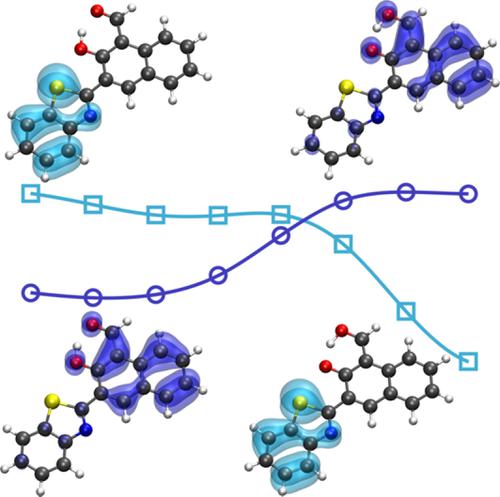当前位置:
X-MOL 学术
›
J. Comput. Chem.
›
论文详情
Our official English website, www.x-mol.net, welcomes your feedback! (Note: you will need to create a separate account there.)
Following the evolution of excited states along photochemical reaction pathways
Journal of Computational Chemistry ( IF 3 ) Pub Date : 2020-05-05 , DOI: 10.1002/jcc.26162 Marco Campetella 1 , Juan Sanz García 2
Journal of Computational Chemistry ( IF 3 ) Pub Date : 2020-05-05 , DOI: 10.1002/jcc.26162 Marco Campetella 1 , Juan Sanz García 2
Affiliation

|
Analyzing the behavior of potential energy surfaces (PESs) of diabatic excited states (ESs) becomes of crucial importance for a complete understanding of complex photochemical reactions. Since the definition of a compact representation for the transition density matrix, the use of the natural transition orbitals (NTOs) has become a routine practice in time‐dependent density functional theory calculations. Their popularity has remarkably grown due to its simple orbital description of electronic excitations. Indeed, very recently, we have presented a new formalism used for the optimization of ESs by tracking the state of interest computing the NTO's overlap between consecutive steps of the procedure. In this new contribution, we generalize the use of this NTO's overlap‐based state‐tracking formalism for the analysis of all the desired diabatic states along any chemical reaction pathway. Determining the PES of the different diabatic states has been automatized by developing an extension of our recently presented algorithm, the so‐called SDNTO: “Steepest Descent minimization using NTOs.” This automatized overlap‐based procedure allows an agile and convenient analysis of the evolution of the ESs avoiding the intrinsic ambiguity of visualizing orbitals or comparing physical observables. The analysis of two photochemical reactions of the same nature with different PES landscapes perfectly illustrates the utility of this new tool.
中文翻译:

跟随激发态沿光化学反应途径的演变
分析非绝热激发态 (ES) 的势能面 (PES) 的行为对于完整理解复杂的光化学反应至关重要。自从定义了跃迁密度矩阵的紧凑表示以来,自然跃迁轨道 (NTO) 的使用已成为瞬态密度泛函理论计算中的常规做法。由于其对电子激发的简单轨道描述,它们的受欢迎程度显着增加。事实上,最近,我们提出了一种新的形式主义,用于通过跟踪计算过程连续步骤之间 NTO 重叠的兴趣状态来优化 ES。在这个新的贡献中,我们概括了这个 NTO' 的使用 基于重叠的状态跟踪形式主义,用于分析任何化学反应途径中所有所需的非绝热状态。通过开发我们最近提出的算法的扩展,即所谓的 SDNTO:“使用 NTO 进行最速下降最小化”,已自动确定不同非绝热状态的 PES。这种基于重叠的自动化程序允许对 ES 的演变进行灵活方便的分析,避免了可视化轨道或比较物理观测值的内在歧义。对具有不同 PES 景观的相同性质的两种光化学反应的分析完美地说明了这种新工具的实用性。通过开发我们最近提出的算法的扩展,即所谓的 SDNTO:“使用 NTO 进行最速下降最小化”,已自动确定不同非绝热状态的 PES。这种基于重叠的自动化程序允许对 ES 的演变进行灵活方便的分析,避免了可视化轨道或比较物理观测值的内在歧义。对具有不同 PES 景观的相同性质的两种光化学反应的分析完美地说明了这种新工具的实用性。通过开发我们最近提出的算法的扩展,即所谓的 SDNTO:“使用 NTO 进行最速下降最小化”,已自动确定不同非绝热状态的 PES。这种基于重叠的自动化程序允许对 ES 的演变进行灵活方便的分析,避免了可视化轨道或比较物理观测值的内在歧义。对具有不同 PES 景观的相同性质的两种光化学反应的分析完美地说明了这种新工具的实用性。
更新日期:2020-05-05
中文翻译:

跟随激发态沿光化学反应途径的演变
分析非绝热激发态 (ES) 的势能面 (PES) 的行为对于完整理解复杂的光化学反应至关重要。自从定义了跃迁密度矩阵的紧凑表示以来,自然跃迁轨道 (NTO) 的使用已成为瞬态密度泛函理论计算中的常规做法。由于其对电子激发的简单轨道描述,它们的受欢迎程度显着增加。事实上,最近,我们提出了一种新的形式主义,用于通过跟踪计算过程连续步骤之间 NTO 重叠的兴趣状态来优化 ES。在这个新的贡献中,我们概括了这个 NTO' 的使用 基于重叠的状态跟踪形式主义,用于分析任何化学反应途径中所有所需的非绝热状态。通过开发我们最近提出的算法的扩展,即所谓的 SDNTO:“使用 NTO 进行最速下降最小化”,已自动确定不同非绝热状态的 PES。这种基于重叠的自动化程序允许对 ES 的演变进行灵活方便的分析,避免了可视化轨道或比较物理观测值的内在歧义。对具有不同 PES 景观的相同性质的两种光化学反应的分析完美地说明了这种新工具的实用性。通过开发我们最近提出的算法的扩展,即所谓的 SDNTO:“使用 NTO 进行最速下降最小化”,已自动确定不同非绝热状态的 PES。这种基于重叠的自动化程序允许对 ES 的演变进行灵活方便的分析,避免了可视化轨道或比较物理观测值的内在歧义。对具有不同 PES 景观的相同性质的两种光化学反应的分析完美地说明了这种新工具的实用性。通过开发我们最近提出的算法的扩展,即所谓的 SDNTO:“使用 NTO 进行最速下降最小化”,已自动确定不同非绝热状态的 PES。这种基于重叠的自动化程序允许对 ES 的演变进行灵活方便的分析,避免了可视化轨道或比较物理观测值的内在歧义。对具有不同 PES 景观的相同性质的两种光化学反应的分析完美地说明了这种新工具的实用性。



























 京公网安备 11010802027423号
京公网安备 11010802027423号